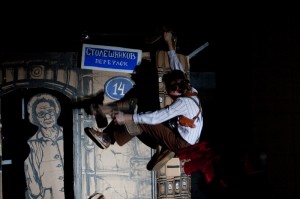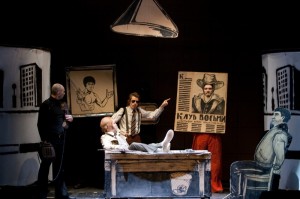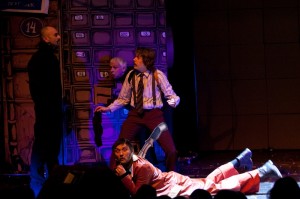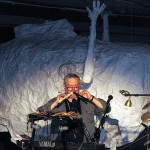Gettots tango
Category: by sophie engström, Centraleuropa, Historia, Jiddisch, music, översättningar, poland, theatre
Tags: Dawid Bajgelman, Förintelsen, Jiddisch, Judisk musik, Tango
Tonerna är omslingrade. Som om de vore i ett väldigt famntag. Här hörs en tango som släpper ut sin hand mot det judiska tonspråket, de glider ledigt över i romsk musik, och kanske letar de sig vidare ändå fram till några enstaka polska folktoner. Men det är inte spretigt och kaotiskt för den delen. Nej, tonerna skapar en alldeles egen och säregen symmetri. Rund till formen tycks den vara. Lite som en bagel, vars runda och mjuka ram lutar in mot ett litet hålrum, där vår fantasi får blomma ut.
Och inte att undra på att tankarna förs till en bagel, enär skaparen av dessa toner lystrade till tilltalsnamnet Dawid Bajgelman.
Dawid Bajgelman föddes i en judisk familj år 1887 eller 1888 i Ostrowiec, en liten ort i sydöstra Polen. Man skulle kunna hävda att han föddes in i musiken, ty hans far var klarinettist, och skulle sedermera få anställning i Łódź symfoniorkester samt verka som dirigent på den judiska teatern Teatr Scala i Łódź. Det var dock inte enbart pappa Szymon och Dawid som var musiker i familjen. Alla nio syskonbarnen (åtta bröder och en syster) spelade. Dawid och en av hans bröder valde violinen som sina huvudinstrument, vilket likaledes flera av de andra syskonen valde. Men även pianot fick känna på deras spelsugna små fingrar. Några av syskonen beslöt sig dock för att satsa på saxofonen och jazzmusiken.
1912, när Dawid Bajgelman var 25 år, blev han utsedd till dirigent på den judiska teatern kallad Ickok Zandberg i Łódź. Tre år senare fick han även anställning på sin fars arbetsplats, alltså symfoniorkestern i Łódź. Samma år tonsatte han operetter till den andra judiska teatern, Teatr Scala, vilket likaledes var pappa Szymons arbetsplats. Men det skulle dröja innan Dawids karriär skulle fart på allvar. Det stora genombrottet kom 1920 då han fick i uppdrag att tonsätta musiken till den judiska pjäsen “Mellan två världar – Dybbuk“. Pjäsen författades på ryska av Shloyme Zanvl Rappoport, mer känd under pseudonymen S. Ansky. Den översattes senare till jiddisch av densamme. Pjäsen handlar om en ung kvinna vars själ blir besatt av sin bortgångne älskades själ, och karaktären går att finna i judisk folktro. Uppsättningen blev en blev en omedelbar succé. Ensemblen, Trupa Wileńska (Vilniustruppen) fick dädanefter turnera land och rike runt för att framföra detta gåtfulla skådespel. Dawid Bajgelmans tonsättningar, där han låtit sig inspireras av de judiska folkmelodierna, bidrog med största sannolikhet till uppsättningens framgångar. Flera av sångerna skulle bli på så populära att de betraktades som riktiga slagdängor.
Dawid Bajgelman var nu en av de mest uppskattade och tongivande tonsättarna och dirigenterna i mellankrigstidens Polen. Han fick uppdrag vid flera olika judiska teatrar. Bland annat syntes hans namn på affischer i Warszawa, Lwów (idag Lviv), Kraków, Rzeszów och på många fler platser i Polen. Under mitten av 1930-talet åkte han ut i vida världen, och människorna i städer som Paris, London och Bryssel fick lyssna på hans alster och se honom dirigera. Hans tonsättningar spelades även in, och då företrädesvis på det legendariska skivbolaget Syrena Rekord, ett av Polens största skivbolag som var verksamt fram till andra världskriget.
Det finns inte mycket information att finna om Dawid Bajgelmans privatliv, men någon gång under 1910-talet gifte sig Dawid Bajgelman med Anna Foderman. Källorna anger inget annat om henne än att hon var skådespelerska, Dawids hustru och att de gemensamt fick en son, Pinchas (Piniek) Bajgelman, som föddes 1915.
När så andra världskriget bröt ut, och Nazityskland ockuperade Polen och Łódź, sattes Dawid i stadens ökända getto. Med honom fanns även hans hustru, Anna. Sonen Piniek, som då var 24 år, flydde till Sovjetunionen där han överlevde Förintelsen. (Efter krigsslutet tog Piniek sig till USA, där han verkade som musiker, fram till sin död 1981.) I gettot startade Dawid genast en symfoniorkester, som bestod av 44 musiker. Den första konserten gavs den första mars 1941, och på repertoaren återfanns flera av Dawid Bajgelmans sånger. Livet i gettot var dock mycket hårt, och Anna skulle avlida, troligen av tyfus eller undernäring. Trots denna sorg fortsatte Dawid att komponera i gettot. Det var nämligen under denna tid som han skrev sina kanske mest emotionella och starka verk. Flera av sångerna vittnar om det mångkulturella Polen som var ett faktum på Dawid Bajgelmans tid. Fundamentet, det som alla tonerna vilar på, är dock tangon. Men här hörs också romernas klagan i “Tsigayner Lid” (Zigenarsång), där romernas lidande beskrivs med orden “zigenare lider/de lever som ingen”. Bland de sånger han skrev under denna tid, och som särskilt utmärker sig är Makh tsi di eygelekh (Slut dina ögon). Sångens text är på jiddisch (precis som alla texter Bajgelman tonsatte) och den skrevs av poeten och författaren Isaiah Shpigl (även Jeszajahu Szpigel), och här är tangon förklädd till en vaggvisa. Ett litet barn på flykt vaggas till sömn, och genom sången lär vi känna de umbäranden som det judiska folket fick utstå under Förintelsen, där Gud tycks ha övergett världen. Sista versen utspelar sig i getto, där blott världens avgrund återstår. “Nakna och bara/Vi blev jagade från vårt hem/Ut i mörkret,/Drivna ut på fälten;/Och storm, hagel och blåst/Har följt oss, mitt barn/Följt med oss in till/Världens avgrund.” Tillsammans med Dawids sorgsna tango förefaller sången frambringa all samlad smärta. Sången var så drabbande att den censurerades av Chaim Rumkowski, ordförande i Juderådet (Judenrat) i gettot i Łódź. Isaiah Shpigl behandlade särskilt bryskt och han deporterades till Auschwitz, men lyckades mirakulöst överleva.
Dawid Bajgelman deporterades också han slutligen till Auschwitz, i den allra sista vågen av deportationer. Enligt överlevare ska Dawid ha varit förvissad om att han skulle överleva. Han packade sin väska full med partitur, och violinen hade han givetvis med sig. Trots att han var så trosviss om en framtid efter Förintelsen, skulle han inte överleva. Bara några dagar efter han anlänt till lägret, mördades han av en berusad lägervakt. Dawid Bajgelman blev 56 eller 57 år gammal.
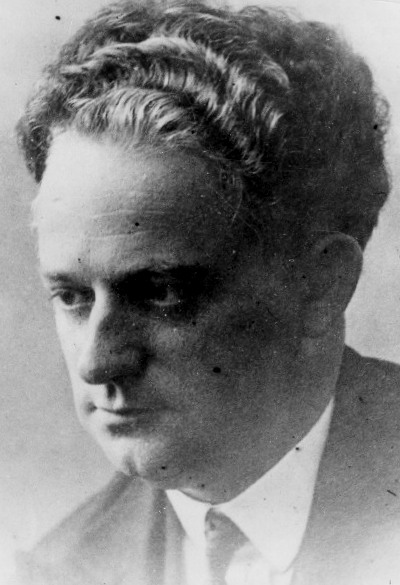
Dawid Bajgelmans sånger och rika musikaliska arv föll i glömska efter Förintelsen. Det är först på senare tid som hans alster åter spelas. På en nyutkommen platta, signerad Bester Quartet, kan man nu lyssna till hur Dawid Bajgelmans sånger åter får nytt liv. Kapellmästaren Jacek Bester har gjort en finkänslig tolkning av Bajgelmans alster från dennes tid i gettot. Vi lotsas varsamt genom Bajgelmans gärning till dess Finale – Makh tsi di eygelekh (Slut dina ögon).
Slut dina ögon
(Översättning från engelska/jiddisch Sonia Engström)
Slut dina små ögon,
Små fåglar kommer,
Cirkla runt
Huvudändan av din vagga.
Bagage i våra händer
Vårt hem i aska
Vi ger oss ut, mitt barn
På jakt efter tur.
Gud har stängt av världen
Och natt är överallt
Som väntar på oss,
Full av skräck och rädsla.
Vi två står här
I denna svåra, svåra stund
Att inte veta var
Vägen leder.
Nakna och bara
Vi blev jagade från vårt hem
Ut i mörkret,
Drivna ut på fälten;
Och storm, hagel och blåst
Har följt oss, mitt barn
Följt med oss in
Världens avgrund.
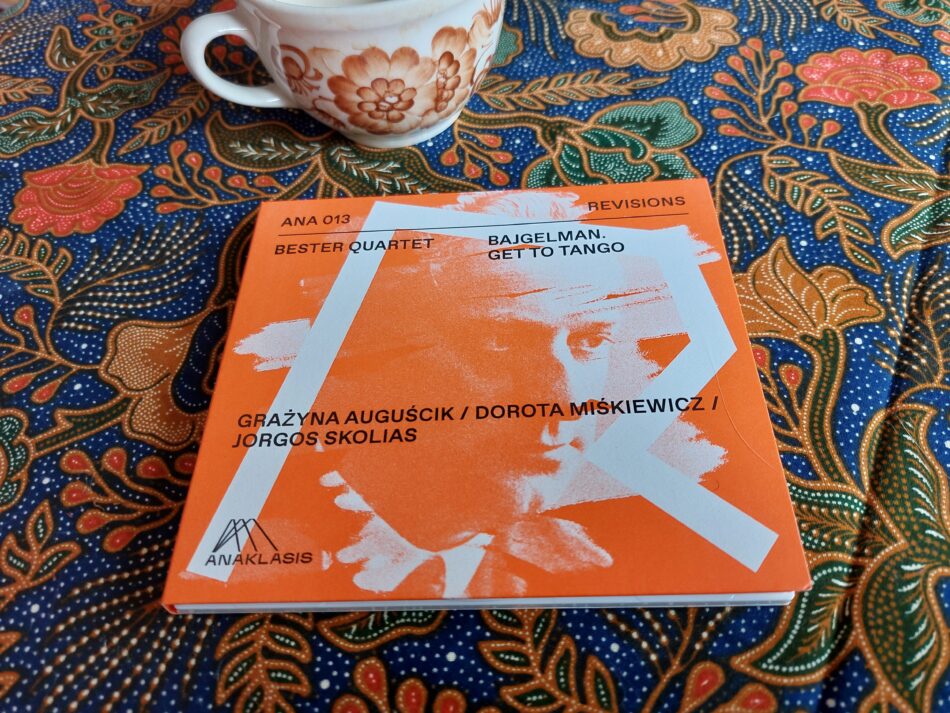
Källor
http://besterquartet.com/releases/bajgelman-get-to-tango/
https://holocaustmusic.ort.org/places/ghettos/lodz/makh-tsi-di-eygelekh/
https://holocaustmusic.ort.org/places/ghettos/lodz/beygelmandavid/
https://en.wikipedia.org/wiki/David_Beigelman
https://en.wikipedia.org/wiki/The_Dybbuk
https://www.antiwarsongs.org/confronta.php?versions=1&ver=11163&id=5445&ver2=-1&lang=en (Slut dina ögon på jiddisch)
https://holocaustmusic.ort.org/places/ghettos/lodz/makh-tsi-di-eygelekh/lyrics/ (Slut dina ögon på engelska)
http://baedekerlodz.blogspot.com/2017/06/dawid-bajgelman-z-muzyka-do-konca.html
m.fl.



